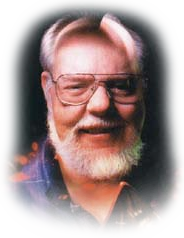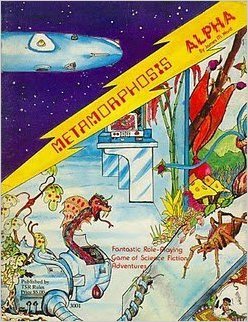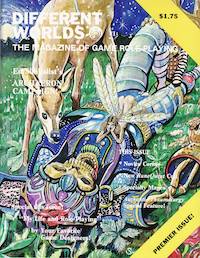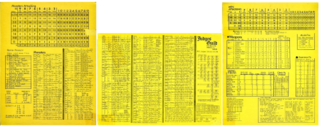
Spelljammer is a campaign setting originally published for the Advanced Dungeons & Dragons role-playing game, which features a fantastic outer space environment. Subsequent editions have included Spelljammer content; a Dungeons & Dragons 5th edition setting update released on August 16, 2022.

David Lance Arneson was an American game designer best known for co-developing the first published role-playing game (RPG), Dungeons & Dragons, with Gary Gygax, in the early 1970s. Arneson's early work was fundamental to the role-playing game (RPG) genre, pioneering devices now considered to be archetypical, such as cooperative play to develop a storyline instead of individual competitive play to "win" and adventuring in dungeon, town, and wilderness settings as presented by a neutral judge who doubles as the voice and consciousness of all characters aside from the player characters.

Kenneth Eugene St. Andre is an American fantasy author and game designer, best known for his work with Tunnels & Trolls and Wasteland. He was born in Ogden, Utah, and has been an active member of The Science Fiction and Fantasy Writers of America since 1989.

Expedition to the Barrier Peaks is a 1980 adventure module for the Dungeons & Dragons role-playing game written by Gary Gygax. While Dungeons & Dragons (D&D) is typically a fantasy game, the adventure includes elements of science fiction, and thus belongs to the science fantasy genre. It takes place on a downed spaceship; the ship's crew has died of an unspecified disease, but functioning robots and strange creatures still inhabit the ship. The player characters fight monsters and robots, and gather the futuristic weapons and colored access cards that are necessary for advancing the story.

An adventure is a playable scenario in a tabletop role-playing game. These can be constructed by gamemasters for their players, and are also released by game publishers as pre-made adventure modules. Different types of designs exist, including linear adventures, where players move between scenes in a pre-determined order; non-linear adventures, where scenes can go in multiple directions; and solo adventures, which are played alone, without a game group.

Empire of the Petal Throne is a fantasy role-playing game designed by M. A. R. Barker, based on his Tékumel fictional universe. It was self-published in 1974, then published by TSR, Inc. in 1975. It was one of the first tabletop role-playing games, along with Dungeons & Dragons, and was the first published RPG game setting. Over the subsequent thirty years, several new games were published based on the Tékumel setting, but to date none have met with commercial success. While published as fantasy, the game is sometimes classified as science fantasy or, debatably, as science fiction.

Metamorphosis Alpha is one of the first science fiction role-playing games, published in 1976. It was created by James M. Ward and originally produced by TSR, the publisher of Dungeons & Dragons.

Buffalo Castle is a gamebook first published by Flying Buffalo in 1976 (ISBN 0-940244-01-2). Using the Tunnels & Trolls role-playing system, Buffalo Castle consists of 150 paragraphs in A4 format.
James M. Ward is an American game designer and fantasy author who worked for TSR, Inc. for more than 20 years.

Different Worlds was an American role-playing games magazine published from 1979 to 1987.

Jennell Jaquays is an American game designer, video game artist, and illustrator of tabletop role-playing games (RPGs). Her notable works include the Dungeons & Dragons modules Dark Tower and Caverns of Thracia for Judges Guild; the development and design of conversions on games such as Pac-Man and Donkey Kong for Coleco's home arcade video game system; and more recent design work, including the Age of Empires series, Quake 2, and Quake III Arena. One of her best known works as a fantasy artist is the cover illustration for TSR's Dragon Mountain adventure.

A tabletop role-playing game, also known as a pen-and-paper role-playing game, is a classification for a role-playing game (RPG) in which the participants describe their characters' actions through speech. Participants determine the actions of their characters based on their characterization, and the actions succeed or fail according to a set formal system of rules and guidelines. Within the rules, players have the freedom to improvise; their choices shape the direction and outcome of the game.

A gamemaster's screen, also called a GM's screen, is a gaming accessory, usually made out of either cardboard or card stock, and is used by the gamemaster to hide all the relevant data related to a tabletop role-playing game session from the players in order to not spoil the plot of the story. It also hides any dice rolls made by the gamemaster that players should not see. In addition, screens often have essential tables and information printed on the inside for the gamemaster to easily reference during play.

Lawrence Schick is a game designer and writer associated with role-playing games.
Free RPG Day is an annual promotional event by the Tabletop role-playing game industry. The event rules are fairly simple: participating publishers provide special free copies of games to participating game stores; the game store agrees to provide one free game to any person who requests a free game on Free RPG Day.

Hex Sheets is a supplement for fantasy role-playing games published by Games Workshop in 1978.

Judge's Shield is a gamemaster's screen created by Judges Guild in 1977 for the fantasy role-playing game Dungeons & Dragons, the first such screen to be published.

Citybook III: Deadly Nightside is a universal role-playing game supplement published by Flying Buffalo and distributed by Task Force Games in 1987.

The Book of Monsters is a supplement for fantasy role-playing games published by Little Soldier Games in 1976.

Dungeon Planner Set 1: Caverns of the Dead is an adventure published by Games Workshop in 1984 for use with fantasy role-playing games.


















